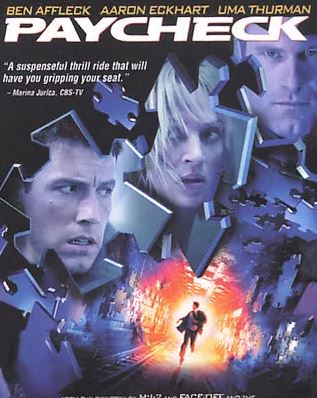In the movie “Paycheck” (2004), the protagonist Michael Jennings (played by Ben Affleck) is accustomed to erasing his own memories. A brilliant engineer, Jennings works on top-secret projects for various companies and then removes all related memories to maintain confidentiality. This time, he signs a major contract to develop a machine that predicts the future, erasing his memories from the past three years. However, upon waking from the memory removal procedure, instead of the promised $4.4 billion, he finds only a bag containing nineteen random items such as a pin, a nail, a coin, and a newspaper puzzle. With the help of his girlfriend and biologist, Rachel (Uma Thurman), Jennings starts piecing together his memories using the items in the bag.
But how can specific memories be erased from someone’s mind? The memory erasure method in the movie involves fixing the person’s head in a machine, similar to a CT scan, and then visualizing and destroying the brain cells associated with those memories. Our neurons are structured in a network, and memories are not stored in individual cells but are formed through circuits of multiple cells. Destroying a single cell cannot eliminate a specific memory, and selectively erasing memories from the past three years seems impossible, as memories are not stored chronologically like a surveillance tape.
The fundamental difference between computers and the human brain lies in how memories are organized. Both biological and computer systems face the challenge of “how to store and retrieve information,” which is essentially memory. Computers assign specific addresses to each piece of memory for storage and retrieval, whereas human memory relies on a network circuit where information is recalled through associations.
For humans, memory addresses are indicated by connected memories, a form of associative thinking. We can remember things better when they are associated with previously known information. Hence, people with extensive knowledge have better learning abilities and recall because their memories are more tightly interconnected. Enhancing our memory capability involves how we store memories in our brain’s network and use associations to recall them.
Memory, like the synapses in the brain, can be viewed as a massive network of interconnected nodes and links. Closely related information forms strong connections, while loosely related information connects through several steps. When one thought arises, closely linked nodes emerge first. For example, the phrase “know yourself” might lead one person to think of “The Art of War,” then “war,” “the Korean War,” “Chinese troops,” and finally a recent trip to Harbin, China. Another person might think of “The Art of War,” followed by “strategy,” “management,” and “our company.”
To enhance our memory, we should assign addresses to the information we need to remember, ensuring these addresses form a dense network. When new information connects naturally to already remembered words, those words become the addresses for the new information. If there is no existing knowledge related to the new information, we can create artificial associations or deliberately distort known words to remember it. For example, the gene “telomere,” which relates to lifespan, can be remembered as “gel I’m mad at.”
Addressing memory involves organizing information into larger, related chunks. For instance, remembering the names of nine minerals (gold, ruby, silver, copper, sapphire, lead, platinum, aluminum, diamond) can be difficult without context. However, categorizing them into precious metals (gold, silver, platinum), common metals (copper, aluminum, lead), and gemstones (ruby, diamond, sapphire) makes them easier to remember. In a 1976 experiment by Stanford psychologist G. H. Bower, participants who learned the names without context remembered about 15%, while those who learned them in meaningful groups recalled about 70%.
The 16th-century Jesuit priest Matteo Ricci introduced the “Memory Palace” technique to the Chinese, where one imagines a grand palace in their mind and assigns information to various rooms. This method is akin to having a well-organized personal library. Information stored in each room stays there until recalled by memory. Addressing memory in this way enhances recall by providing multiple associative paths.
Reinforcing memory with multiple addresses and links strengthens the network, similar to how visual and auditory education enhances recall. Great memory masters like Matteo Ricci emphasize visualizing information, as images serve as large memory units and additional addresses for retrieval. Repetition is essential for memory, but looking at a topic from various perspectives also strengthens the memory network.
The neural circuits in our brain become denser with new thoughts, akin to an expanding network of flight paths at new airports. Leonardo da Vinci is often cited as someone who utilized his brain most efficiently, achieving remarkable results across various fields. According to Michael Gelb, author of “How to Think Like Leonardo da Vinci,” his abilities stemmed from relentless curiosity and the habit of connecting ideas across different fields.
Long-term memory stored in the brain is never truly forgotten, but we often fail to retrieve certain information, which we call forgetting. Forgetting might be a blessing, allowing us to move past embarrassing or painful memories. However, this blessing necessitates repetitive learning. Hermann Ebbinghaus, who proposed the concept of the forgetting curve, found that information starts fading after 10 minutes, with a sharp decline over four hours, 70% gone after one day, and 80% after one month.
Most information remains in short-term memory and quickly fades. Ebbinghaus discovered that reviewing information at strategic intervals significantly aids retention: reviewing after 10 minutes, one day, one week, and one month helps retain information for longer periods. Understanding information enhances memory, as meaningful context improves retention.
Knowledge accelerates the more it is absorbed. Acquiring and remembering a piece of knowledge means not just receiving that information, but also learning how to remember it.
When you learn one thing, you also improve your ability to learn other things. This is because existing knowledge forms a background that helps you absorb new information more efficiently and quickly. Our brains don’t just store information; they connect it to create new knowledge or wisdom. In fact, our brains constantly classify new information and reorganize existing knowledge through these stimuli. When we need to solve something, our brains can combine seemingly unrelated pieces of information to create the knowledge we need. This constant rearrangement of ‘thought connections’ leads to progress. Sometimes, this process can combine unrelated ideas to produce surprisingly interesting and innovative thoughts—this is creativity. Just as our lives are networks, so too is our knowledge, which achieves its full potential when it forms a well-connected network.
The hippocampus in the brain plays a key role in converting short-term memory into long-term memory. On a typical morning commute, we encounter many people. The images of these people remain momentarily in the visual cortex of the occipital lobe as short-term memory. If we don’t pay much attention, the memory quickly fades. However, if we observe someone with interest, the hippocampus processes this as important information and stores it. These memories are initially short-term. Among these, truly important ones are reclassified by the hippocampus and transferred to the neocortex for long-term storage, which is why the hippocampus is often referred to as the ‘factory of memory’. Next to the hippocampus is the amygdala, which evaluates whether something is good or bad. Depending on the intensity of these emotions, the amygdala stimulates the hippocampus.
Naturally, we remember things better if they interest us or if they are strong survival stimuli. This means our brains retain information better when it’s recognized as crucial for our survival and growth. The fact that we remember sad and joyful experiences better is a simple validation of this idea. Children easily absorb and remember new information because, at their age, everything is new and fresh. This indicates that a clear motivation or purpose for memorizing something improves our ability to remember it.
In school, some friends might particularly remember lines from movies or phrases from novels. They often memorize romantic lines to use them as needed. Sometimes they use these lines in inappropriate situations, but they always seem successful. One of our friends would recite the famous line from the movie Love Story, “Love means never having to say you’re sorry,” perfectly. They showed impressive memory skills because they had a clear purpose and motivation.
Eran Katz, who holds the Guinness World Record for memory, advises that to enhance memory, one should first think about the benefits of learning something. He further emphasizes considering the disadvantages of not learning it. Ultimately, the most important factor in boosting memory is motivation. Some people read newspapers on crowded subways, not for a particular purpose but out of boredom or with no significant meaning attached to the information they’re taking in. Such knowledge is unlikely to last long because there’s no purpose behind the learning. If another category of knowledge were to be added to the OECD’s four types, it should be ‘knowing what to learn for’. We might call this ‘know-for-what’ knowledge.
We need to understand the purpose of the knowledge we encounter to transform a single piece of information into knowledge and eventually into wisdom. However, this is only possible if we first remember the necessary knowledge and information. Although we can’t remember everything, we should make an effort to remember even the trivial things we encounter daily. Some of these will relate to our past memories, enriching our database and fostering more creative thinking by connecting these memories.


답글 남기기